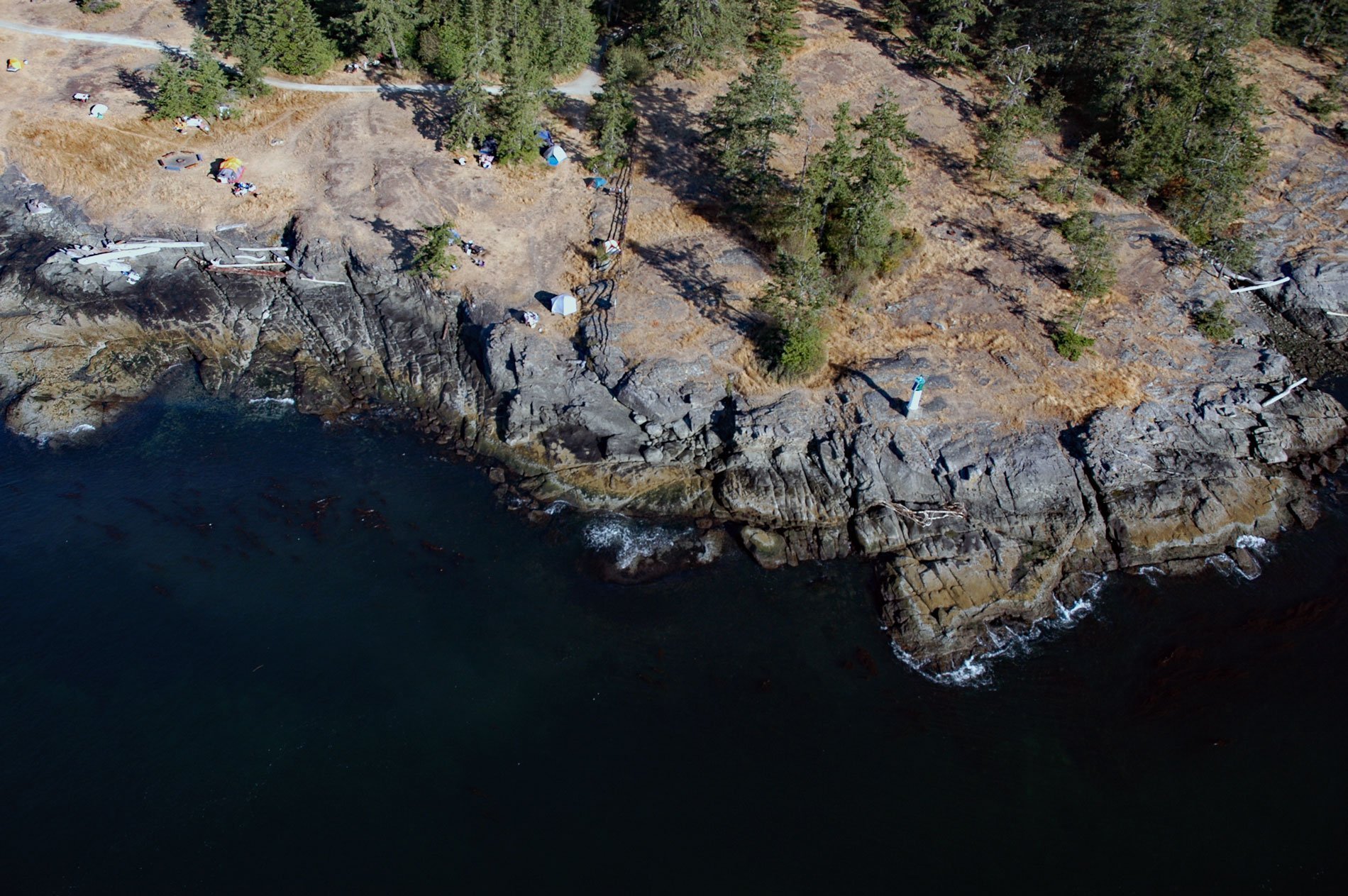Beaver Point is a prominent headland in Ruckle Provincial Park on the southeastern shore of Salt Spring Island in the Southern Gulf Islands and at the northwestern end of Swanson Channel, about 8 miles (13 km) north-northeast of Sidney and 4 miles (6 km) east of Fulford Harbour, British Columbia. The point was named in 1859 after the Hudson’s Bay Company paddle steamer Beaver that was leased at that time to the British Admiralty and under the command of Captain George H. Richards, followed by Captain Daniel Pender, who conducted hydrographic surveys of the British Columbia coast. Ruckle Provincial Park is named after Henry Ruckle who immigrated from Ireland and homesteaded here in 1872, He married Ella Anna Christensen and they and their descendants farmed the Salt Spring property for more than a century before donating their land to BC Parks in 1972. Beaver Point is composed of sedimentary rock in the Nanaimo Group of the Wrangellia terrane which is named for the Wrangell Mountains in Alaska. The terrane is an accretionary wedge that was added to the North American continental margin in Late Jurassic or Early Cretaceous time and extends along the coast from the south-central part of Alaska to British Columbia. It is composed of Devonian volcanic arc and sedimentary rocks, Permian sedimentary rocks, Late Triassic basalt and carbonate rocks, and Early Jurassic volcanic arc rocks. These rocks record a history of arc volcanism, ocean plateau formation, and marine carbonate deposition. The Nanaimo Group was formed during the Late Cretaceous and consists of eleven different sandstone formations. At Beaver Point, the bedrock is mostly fine-grained sandstone of the Comox Formation. Inland from the coast, the bedrock is overlain by thick layers of unconsolidated glacial till.
First Nations people used this area for millennia to gather shellfish and harvest camas. The Cowichan people called the island Chu’an and believed that the rounded summit on the southern end with few trees and shrubs and an elevation of 1,971 feet was one of the resting places of Swa’quawa, the Thunderbird, where he paused in his flight from the ocean to his home among the inland mountains. The island is part of the traditional territory of the Saanich, Cowichan, and Chemainus First Nations, and aboriginal use of the island dates back at least 5,000 years. The main settlements were at HwnJ’nuts which is now called Fulford Harbour, Shiyahwt at present-day Ganges, StsBth at Long Harbour, and Puqdnup at Hudson Point. A major epidemic in the 1780s and subsequent warfare with northern peoples shifted resident populations to villages on Vancouver Island, Kuper Island, and Valdes Island. Some people remained at the present-day Tsawout Indian Reserve on Fulford Harbour until the 1920s, making this the longest continually occupied place on the island. A map made for Governor James Douglas during a canoe voyage in 1852 labeled the island as Chuan. Joseph D. Pemberton, the Colonial Surveyor from 1851 to 1864, mentioned the island several times as ‘Tuan or Salt Spring Island’. The altered spelling of the first name is probably due to the difficulty of accurately reproducing the Coast Salish sound. In 1859, the island’s name was changed to Admiral Island by Captain George H. Richards, who conducted the coastal surveys from 1857 to 1863. Despite this, ‘Saltspring’ became the popular name, and in 1906, superseded ‘Admiral’ as the official designation.
In the aftermath of the Fraser Canyon Gold Rush, many immigrants from Britain, America, France, Germany, and Australia were desperate for a place to settle and lingered in Victoria in the hope that they might acquire land and become self-sufficient residents of the colony. Some chose Salt Spring Island, despite the fact that the island was isolated from centers of civilization by the Salish Sea, that it was geographically rugged and covered by huge Douglas firs that had to be cleared before farming could take place, and that no treaties had been signed with the aboriginal peoples who used the island as a hunting and fishing reserve and considered it theirs. About half of the first settlers were African Americans from San Francisco who had come to Victoria in 1858 seeking an environment in which they had the same rights as everyone else. Before steamer service began in 1889, Salt Spring Islanders had to row to Vancouver Island for supplies. Henry Ruckle built a wharf at a sheltered cove north of Beaver Point to provide local settlers with an easier link to Vancouver Island. By 1900, there were six scheduled sailings per week from the Beaver Point Wharf, including two for mail deliveries. The government purchased the wharf in 1904 for $400, rebuilt it in 1910, and then again in 1925. The wharf housed a general store, post office, and the residence of Mr. and Mrs. William Patterson from 1915 until the 1950s. When the ferry service moved from Beaver Point to Fulford Harbour, the Patterson business moved with it, and the wharf and building were dismantled in 1960. Ruckle Provincial Park is now one of the largest provincial parks in the Gulf Islands. The park protects a mosaic of wetlands, Garry oaks, flowering meadows, old forests, and 4 miles (7 km) of shoreline habitats. Read more here and here. Explore more of Beaver Point and Salt Spring Island here:

